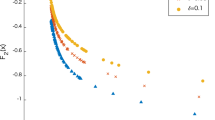Abstract
Many descent algorithms for multiobjective optimization have been developed in the last two decades. Tanabe et al. (Comput Optim Appl 72(2):339–361, 2019) proposed a proximal gradient method for multiobjective optimization, which can solve multiobjective problems, whose objective function is the sum of a continuously differentiable function and a closed, proper, and convex one. Under reasonable assumptions, it is known that the accumulation points of the sequences generated by this method are Pareto stationary. However, the convergence rates were not established in that paper. Here, we show global convergence rates for the multiobjective proximal gradient method, matching what is known in scalar optimization. More specifically, by using merit functions to measure the complexity, we present the convergence rates for non-convex (\(O(\sqrt{1 / k})\)), convex (O(1/k)), and strongly convex (\(O(r^k)\) for some \(r \in (0, 1)\)) problems. We also extend the so-called Polyak-Łojasiewicz (PL) inequality for multiobjective optimization and establish the linear convergence rate for multiobjective problems that satisfy such inequalities (\(O(r^k)\) for some \(r \in (0, 1)\)).
Similar content being viewed by others
Notes
We say that \(h :\mathbf {R}^n \rightarrow \mathbf {R}\cup \{ \infty \}\) has a convexity parameter \(\varsigma \in \mathbf {R}\) if \(h(\alpha x + (1 - \alpha )y) \le \alpha h(x) + (1 - \alpha )h(y) - (1 / 2)\alpha (1 - \alpha ) \varsigma \left\Vert x - y\right\Vert ^2\) holds for all \(x, y \in \mathbf {R}^n\) and \(\alpha \in [0, 1]\). When \(\varsigma > 0\), we call h strongly convex. Note that this definition allows non-convex cases, i.e., \(\varsigma < 0\) can also be considered.
References
Beck, A.: First-order methods in optimization. Society for Industrial and Applied Mathematics (2017). https://doi.org/10.1137/1.9781611974997
Beck, A., Teboulle, M.: A fast iterative shrinkage-thresholding algorithm for linear inverse problems. SIAM J. Imag. Sci. 2(1), 183–202 (2009). https://doi.org/10.1137/080716542
Bello-Cruz, Y., Melo, J.G., Serra, R.V.: A proximal gradient splitting method for solving convex vector optimization problems. Optimization (2020). https://doi.org/10.1080/02331934.2020.1800699
Bertsekas, D.P.: Nonlinear programming, 2nd edn. Athena Scientific, Belmont, Mass (1999)
Boţ, R.I., Grad, S.M.: Inertial forward-backward methods for solving vector optimization problems. Optimization 67(7), 959–974 (2018). https://doi.org/10.1080/02331934.2018.1440553
Bonnel, H., Iusem, A.N., Svaiter, B.F.: Proximal methods in vector optimization. SIAM J. Optim. 15(4), 953–970 (2005). https://doi.org/10.1137/S1052623403429093
Calderón, L., Diniz-Ehrhardt, M.A., Martínez, J.M.: On high-order model regularization for multiobjective optimization. Optim. Methods. Softw. (2020). https://doi.org/10.1080/10556788.2020.1719408
Carrizo, G.A., Lotito, P.A., Maciel, M.C.: Trust region globalization strategy for the nonconvex unconstrained multiobjective optimization problem. Math. Program. 159(1–2), 339–369 (2016). https://doi.org/10.1007/s10107-015-0962-6
Custódio, A.L., Madeira, J.F., Vaz, A.I., Vicente, L.N.: Direct multisearch for multiobjective optimization. SIAM J. Optim. 21(3), 1109–1140 (2011). https://doi.org/10.1137/10079731X
Fliege, J., Graña Drummond, L.M., Svaiter, B.F.: Newton’s method for multiobjective optimization. SIAM J. Optim. 20(2), 602–626 (2009). https://doi.org/10.1137/08071692X
Fliege, J., Svaiter, B.F.: Steepest descent methods for multicriteria optimization. Math. Methods Oper. Res. 51(3), 479–494 (2000). https://doi.org/10.1007/s001860000043
Fliege, J., Vaz, A.I., Vicente, L.N.: Complexity of gradient descent for multiobjective optimization. Optim. Methods. Softw. 34(5), 949–959 (2019). https://doi.org/10.1080/10556788.2018.1510928
Fukuda, E.H., Graña Drummond, L.M.: A survey on multiobjective descemt methods. Pesquisa Operacional 34(3), 585–620 (2014). https://doi.org/10.1590/0101-7438.2014.034.03.0585
Fukushima, M., Mine, H.: A generalized proximal point algorithm for certain non-convex minimization problems. Int. J. Syst. Sci. 12(8), 989–1000 (1981). https://doi.org/10.1080/00207728108963798
Graña Drummond, L.M., Iusem, A.N.: A projected gradient method for vector optimization problems. Comput. Optim. Appl. 28(1), 5–29 (2004). https://doi.org/10.1023/B:COAP.0000018877.86161.8b
Grapiglia, G.N., Yuan, J., Yuan, Y.X.: On the convergence and worst-case complexity of trust-region and regularization methods for unconstrained optimization. Math. Program. 152(1–2), 491–520 (2015). https://doi.org/10.1007/s10107-014-0794-9
Hoffman, A.J.: On approximate solutions of systems of linear inequalities. J. Res. Natl. Bur. Stand. 49(4), 263–265 (1952). https://doi.org/10.1142/9789812796936_0018
Karimi, H., Nutini, J., Schmidt, M.: Linear convergence of gradient and proximal-gradient methods under the Polyak-Łojasiewicz condition. In: P. Frasconi, N. Landwehr, G. Manco, J. Vreeken (eds.) Machine Learning and Knowledge Discovery in Databases, pp. 795–811. Springer International Publishing, Cham (2016). https://doi.org/10.1007/978-3-319-46128-1_50
Lucambio Pérez, L.R., Prudente, L.F.: Nonlinear conjugate gradient methods for vector optimization. SIAM J. Optim. 28(3), 2690–2720 (2018). https://doi.org/10.1137/17M1126588
Nesterov, Y.: Introductory lectures on convex optimization: A basic course. Kluwer Academic Publishers, Dordrecht (2004). https://doi.org/10.1007/978-1-4419-8853-9
Polyak, B.: Gradient methods for minimizing functionals (in Russian). Zh. Vychisl. Mat. Mat. Fiz. 3(4), 643–653 (1963). https://doi.org/10.1016/0041-5553(63)90382-3
Sion, M.: On general minimax theorems. Pacific J. Math. 8(1), 171–176 (1958). https://doi.org/10.2140/pjm.1958.8.171
Tanabe, H., Fukuda, E.H., Yamashita, N.: Proximal gradient methods for multiobjective optimization and their applications. Comput. Optim. Appl. 72(2), 339–361 (2019). https://doi.org/10.1007/s10589-018-0043-x
Tanabe, H., Fukuda, E.H., Yamashita, N.: New merit functions for multiobjective optimization and their properties. arXiv: 2010.09333 (2022)
Acknowledgements
This work was supported by the Grant-in-Aid for Scientific Research (C) (17K00032 and 19K11840) and Grant-in-Aid for JSPS Fellows (20J21961) from the Japan Society for the Promotion of Science. We are also grateful to the anonymous referees for their useful comments.
Author information
Authors and Affiliations
Corresponding author
Additional information
Publisher's Note
Springer Nature remains neutral with regard to jurisdictional claims in published maps and institutional affiliations.
Rights and permissions
About this article
Cite this article
Tanabe, H., Fukuda, E.H. & Yamashita, N. Convergence rates analysis of a multiobjective proximal gradient method. Optim Lett 17, 333–350 (2023). https://doi.org/10.1007/s11590-022-01877-7
Received:
Accepted:
Published:
Issue Date:
DOI: https://doi.org/10.1007/s11590-022-01877-7



